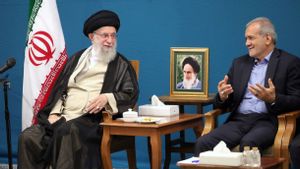JAKARTA - The Union of Soviet Socialist Republics (URSS) or the Soviet Union is a socialist country that existed between 1922-1991. The country was founded by the Russian RSFS, the Transcaucasian RSFS, the Ukrainian RSS and the Byelorussian RSS. Unfortunately, this country that was once a superpower loved the United States, but did not live long. Today, December 26, 1991, the Soviet Union officially dissolved. What caused it?
Before its dissolution, the USSR was the largest country on earth. Its area covers 22,400,000 square km or more than double the size of its rival country, the US, covering an area of 9,826,675 km2. An area of that size, inhabited by a population of 290 million people.
Under Josef Stalin, from 1941 to 1953, the country flourished. Stalin led the country through a massive industrialization process with a planned economy.
In World War II in 1945 the Soviet Union defeated Nazi German troops. This country is getting stronger because it is armed with tens of thousands of nuclear weapons. Until many Eastern Bloc countries docked and finally the Soviet Union established the Warsaw Pact alliance in 1955.
In addition, the fangs of the USSR were increasingly visible from the space program of the 1960s. The Soviets held the record for being the first country to fly humans into space.
Unfortunately, a series of classy achievements did not last long, entering the beginning of 1991 the soviets began to show signs of division. The leaders of Russia, Ukraine, and Belarus signed the agreement governing the commonwealth of independent countries on December 8, 1991. From there it was the first sign of the dissolution of the Soviet Union.

The Main Factor of the Soviet Collapse
Russia Beyond notes there are three main reasons why the Soviet state dissolved. First is because of the problem of the country's weakening economy.
One of the supporting sectors of the Soviet Union's economy came from oil exports. When the price of oil fell, it clearly affected the economy of the communist country a lot.
So on September 13, 1985, Saudi Arabia's Minister of Petroleum, Ahmed yamani, declared his country out of an agreement to restrict oil production and began ramping up production in the oil market. After that, Saudi Arabia increased its oil production by 5.5 times. This caused world oil prices to drop 6.1 times.
Russian Economy Minister Pyotr Aven said the incident was a turning point in the collapse of the Soviet economy. "That was a major turning point in 1986. When oil prices fell, all the possibilities for generating income (for the Soviet Union) collapsed," he told Russia Beyond.
Meanwhile, the fall in oil prices coincided with an economic slowdown, which, according to Aven, had started in the 1960s. This trend was exacerbated by the decline in oil revenues, leading to the collapse of the Soviet economic model.
As the Soviet economy weakened, prompting the then Soviet leader Mikhail Gorbachev to carry out reforms by producing a fairly radical policy, namely perestroika (rebuilding). Perestroika tried to reform the Soviet system, which at that time was showing signs of decline. Gorbachev's reforms are also cited as the second factor in the dissolution of the Soviet Union.
Gorbachev's first reforms, the so-called "economic acceleration", were supposed to unleash the potential of "modern socialism". But Soviet-born American sociologist Vladimir Shlapentokh called these reforms "neo-Stalinist" because they were carried out in the same paradigm as the policies of Gorbachev's violent predecessors.
This policy was considered to have failed to accelerate the Soviet economy, and on the contrary, it weakened the country. "In order to modernize the economy, Gorbachev initiated a process of radical democratization which made the inevitable demise of the Soviet system and the state."
In addition, in the late 1980s, during the Perestroika period there was also an increase in violence caused by ethnic rivalries in the Soviet republics. This was also predicted as the third factor in the collapse of the Soviet Union.
For example, the ethnic violence that occurred in 1986 in the capital of Kazakhstan, Almaty. At that time, young Kazakhs were not satisfied with the appointment of the head of their republic who was an ethnic Russian. The demonstration then led to riots.
Apart from this, there were also massacres in the city of Sumgait, Azerbaijan, and acts of violence in Tbilisi, Baku and other places throughout the country. The bloodiest conflict occurred in Karabakh between Azerbaijan and Armenia, which is sometimes referred to as "one of the main political triggers that initiated the disintegration of the Soviet Union". In the late 1980s, ethnic conflict turned deadly, killing hundreds in fighting.
The poor economic performance and rampant horizontal conflicts could not be resolved by the Gorbachev government at that time. Because it was getting out of control finally on December 25, 1991, Mikhail Gorbachev announced his resignation as president of the Soviet Union. At the Kremlin, the Soviet flag was lowered for the last time.
"Divisions in society and struggles in a country like ours which is full of weapons, including nuclear, could result in the death of many people and destruction. I could not allow that to happen just to stay in power. Resigning was my victory," Gorbachev was quoted as saying. BBC.
The next day, on December 26, 1991, today 28 years ago, the Soviet Union officially dissolved, marked by the Russian government's takeover of the Soviet Union's offices.
The English, Chinese, Japanese, Arabic, and French versions are automatically generated by the AI. So there may still be inaccuracies in translating, please always see Indonesian as our main language. (system supported by DigitalSiber.id)












